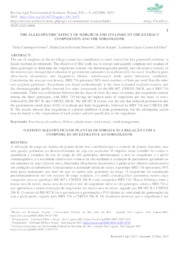The allelopathic effect of sorghum and its links to the extract composition and the sorgoleone.
The allelopathic effect of sorghum and its links to the extract composition and the sorgoleone.
Author(s): GOMES, T. C.; SIMEONE, M. L. F.; KARAM, D.; DIAS, L. L. C.
Summary: The use of sorghum on the no-tillage system has contributed to weed control but has generated problems in future soybean development. The objective of this work was to extract and quantify sorghum root exudate of three genotypes to determine the sorgoleone content, the chromatographic profile, and the relative toxicity of the root extracts through the evaluation of germination parameters in soybean (Glycine max), brachiaria grass (Brachiaria decumbens) and beggarticks (Bidens subalternans) seeds under laboratory conditions. Considering the average root density, BRS 716 presented 50% more numbers of hairs per mm² than the other two sorghum genotypes. Sorgoleone was found predominantly in the three evaluated sorghum extracts, and the chromatographic profile detected five other compounds for the BR 007, CMSXS 206 B, and 6 BRS 716 compounds. There was a difference between the dry mass of roots, dry mass of extract, and sorgoleone content among the three genotypes, with BRS 716 having the highest ratio of sorgoleone per dry mass of roots, followed by BR 007 B, and CMSXS 206 B. The BR 007 B extract was the one that reduced germination and the germination speed index (GSI) of soybean and hairy beggarticks, followed by BRS 716 and CMSXS 206 B. The results showed that sorgoleone is a potent inhibitor of plant germination, but the allelopathic action may be linked to the composition of each extract and not specifically to the sorgoleone.
Publication year: 2023
Types of publication: Journal article
Unit: Embrapa Maize & Sorghum
Keywords: Brachiaria Decumbens, Controle, Erva Daninha, Planta daninha
Observation
Some of Embrapa's publications are published as ePub files. To read them, use or download one of the following free software options to your computer or mobile device. Android: Google Play Books; IOS: iBooks; Windows and Linux: Calibre.
Access other publications
Access the Agricultural Research Database (BDPA) to consult Embrapa's full library collection and records.
Visit Embrapa Bookstore to purchase books and other publications sold by Embrapa.

